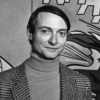Roy Lichtenstein

Roy Lichtenstein
Roy Fox Lichtensteinwas an American pop artist. During the 1960s, along with Andy Warhol, Jasper Johns, and James Rosenquist among others, he became a leading figure in the new art movement. His work defined the basic premise of pop art through parody. Favoring the comic strip as his main inspiration, Lichtenstein produced hard-edged, precise compositions that documented while it parodied often in a tongue-in-cheek manner. His work was heavily influenced by both popular advertising and the comic book style. He...
NationalityAmerican
ProfessionPop Artist
Date of Birth27 October 1923
CityNew York City, NY
CountryUnited States of America
We like to think of industrialization as being despicable. I don't really know what to make of it. There’s something terribly brittle about it. I suppose I would still prefer to sit under a tree with a picnic basket rather than under a gas pump, but signs and comic strips are interesting as subject matter. There are certain things that are usable, forceful, and vital about commercial art. We're using those things – but we're not really advocating stupidity, international teenagerism, and terrorism.
When I met Steve Kaufman, I thought he was Gene Simmons, but what an artist talent he is. He will be an art force in the art world to deal with.
I think that most people think painters are kind of ridiculous, you know?
The big tradition, I think, is unity. And I have that in mind; and with that, you know, you could break all the traditions- all the other so-called rules, because they are stylistic.. and most are not true. As long as the marks are related to one another, there is unity. Unity in the work itself depends on unity of the artist's vision.
Art doesn't transform. It just plain forms.
I don't think of form as a kind of architecture. The architecture is the result of the forming. It is the kinesthetic and visual sense of position and wholeness that puts the thing into the realm of art.
Pop Art is industrial painting. I think the meaning of my work is that it is industrial, it's what all the world will soon become. Europe will be the same way, soon, it won't be American; it will be universal.
All my art is in some way about other art, even if the other art is cartoons.
But usually I begin things through a drawing, so a lot of things are worked out in the drawing. But even then, I still allow for and want to make changes.
I take a cliche and try to organize its forms to make it monumental. The difference is often not great, but it is crucial.
There must be something about art... almost all cultures have done art. It's a refining of the senses, which are there to keep us alive. As far as we know, no other animals do that.
Outside is the world; it's there. Pop Art looks out into the world.
My work sanitizes it (emotion) but it is also symbolic of commercial art sanitizing human feelings. I think it can be read that way.... People mistake the character of line for the character of art. But it's really the position of line that's important, or the position of anything, any contrast, not the character of it.
Organized perception is what art is all about.